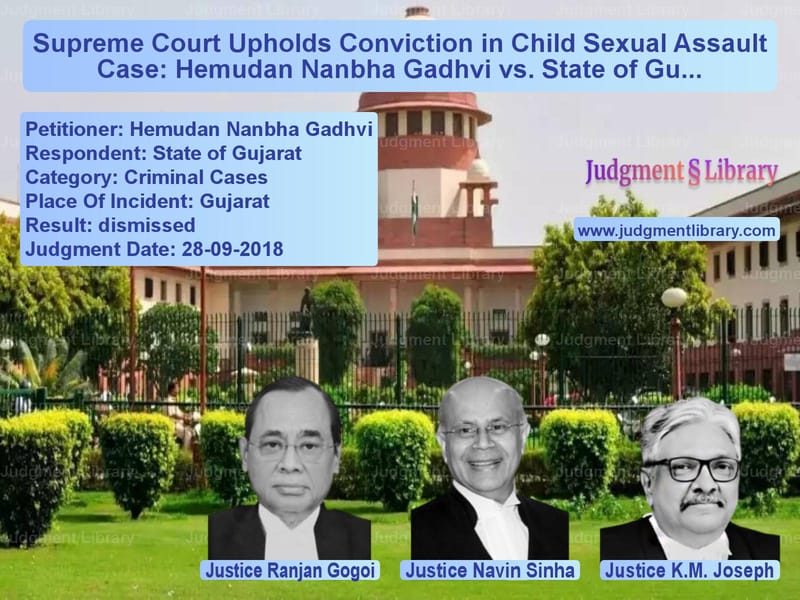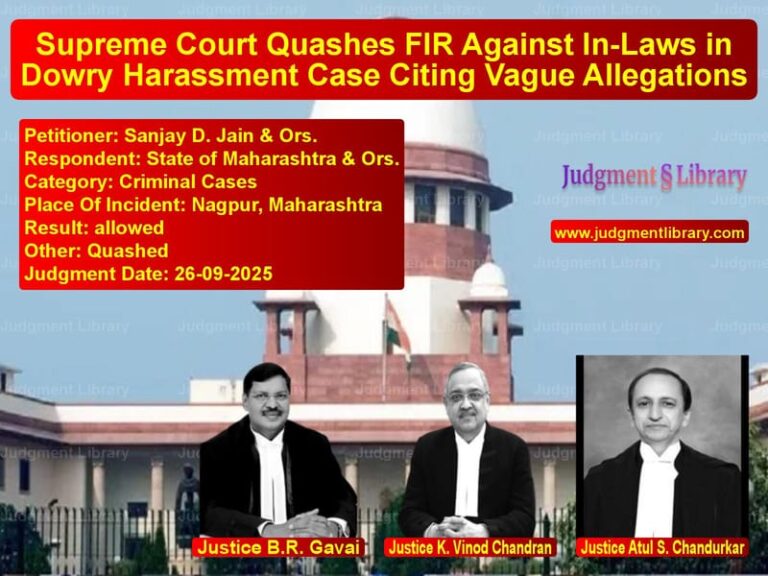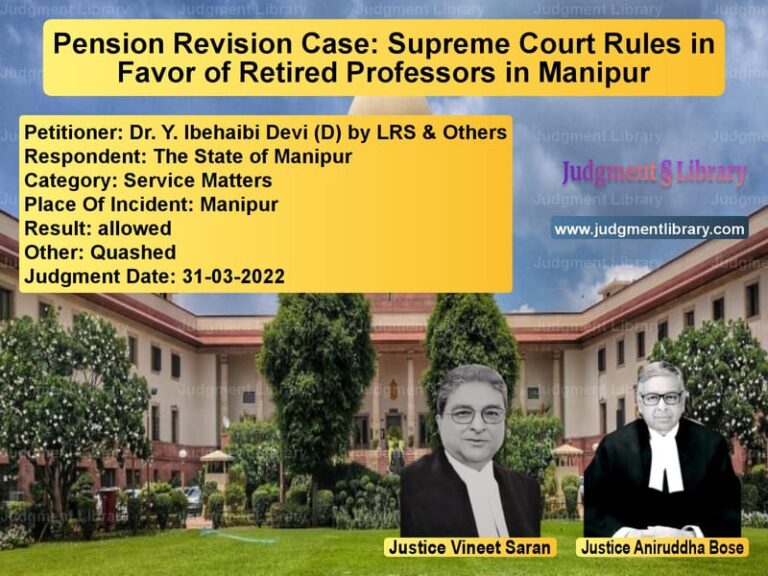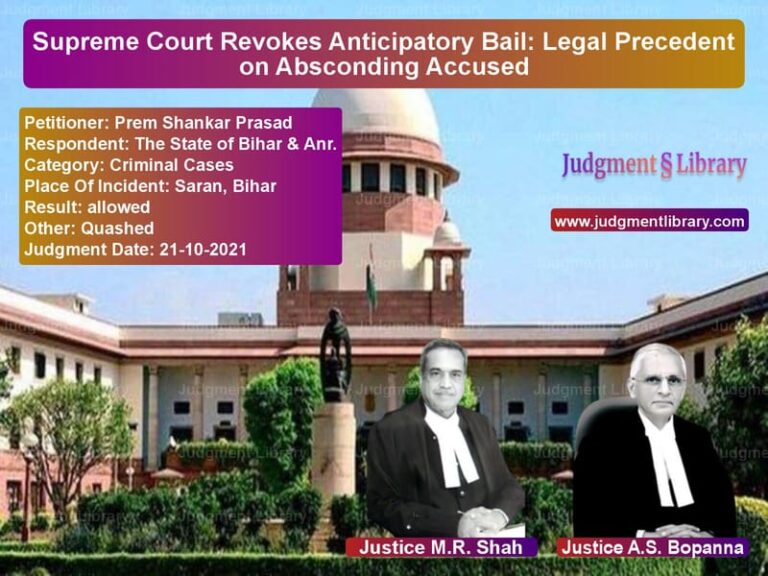Supreme Court Upholds Conviction in Child Sexual Assault Case: Hemudan Nanbha Gadhvi vs. State of Gujarat
The Supreme Court’s judgment in Hemudan Nanbha Gadhvi vs. State of Gujarat, delivered on September 28, 2018, dealt with a crucial case concerning child sexual assault. The Court upheld the conviction of the appellant, reversing his prior acquittal by the trial court. The case highlights the significance of forensic evidence, the reliability of a Test Identification Parade (T.I.P.), and the necessity to ensure justice in cases involving vulnerable victims.
Background of the Case
The case revolved around the sexual assault of a 9-year-old girl on February 20, 2004. The victim (PW-2) was accompanied by another minor (PW-3) when the assault took place. PW-3 informed the victim’s mother (PW-1), who promptly lodged a First Information Report (FIR) the same day.
The victim was medically examined the same day by PW-9 Dr. Meghna Narendrabhai Mehta, who confirmed the occurrence of sexual assault based on forensic evidence:
- Rupture of the hymen.
- Fresh blood oozing from injuries.
- A wound measuring 1.5 cm to 2 cm extending to the lower body.
Following investigations, two suspects, including the appellant, were taken into custody. A Test Identification Parade (T.I.P.) was conducted on February 22, 2004, two days after the incident. The victim identified the appellant in the T.I.P.
Trial Court Proceedings and Acquittal
During the trial, held six months after the incident, both the victim (PW-2) and PW-3 denied the occurrence of sexual assault and failed to identify the appellant in court.
Based on their testimony, the trial court acquitted the appellant, concluding that there was insufficient evidence to establish guilt beyond a reasonable doubt.
High Court Reverses Acquittal
The State of Gujarat filed an appeal before the Gujarat High Court. The High Court analyzed the evidence and ruled that:
- The FIR was duly proved by PW-12, Police Sub-Inspector Bachubhai P. Kalsariya.
- The medical examination and forensic evidence, including the presence of semen on the victim’s clothes, corroborated the assault.
- The serological report confirmed that the semen matched the blood group of the appellant (Group B).
- The appellant was identified in the T.I.P., conducted promptly within two days of the crime.
The High Court concluded that the appellant had likely influenced the victim and other witnesses due to the delay in the trial and ruled that the evidence was sufficient to convict him under Section 376(2)(f) of the Indian Penal Code (IPC). The appellant was sentenced to ten years of rigorous imprisonment and fined Rs. 5,000.
Supreme Court’s Observations
The appellant challenged the High Court’s ruling before the Supreme Court, arguing that:
- The T.I.P. was only corroborative evidence and could not be treated as substantive proof of identity.
- There was no reliable identification of the appellant during the trial.
- The serological report was not formally exhibited, and its author was not examined.
- The appellant was not given a fair opportunity to contest the serological evidence during his Section 313 Cr.P.C. statement.
Supreme Court’s Ruling
The Supreme Court upheld the conviction and dismissed the appeal, making the following key observations:
1. Test Identification Parade (T.I.P.)
The Court noted that while T.I.P. is usually corroborative, its evidentiary value increases when:
- There is no other reasonable explanation for the victim identifying the accused.
- The identification is supported by forensic evidence.
Referring to Prakash vs. State of Karnataka (2014) 12 SCC 133, the Court held:
“Even so, the failure of a victim or a witness to identify a suspect is not always fatal to the case of the prosecution.”
2. Impact of Witnesses Turning Hostile
The Court observed that witnesses turning hostile cannot be the sole ground for acquittal. It referred to State vs. Sanjeev Nanda (2012) 8 SCC 450:
“If a witness becomes hostile to subvert the judicial process, the court shall not stand as a mute spectator. Every effort should be made to bring home the truth.”
Since the victim was just 9 years old at the time of the assault and came from a poor family, the Court noted that she could have been influenced through coercion, intimidation, or persuasion.
3. Admissibility of Forensic Evidence
The Court rejected the appellant’s argument that the serological report was inadmissible because:
- Expert reports under Section 45 of the Indian Evidence Act, 1872, are admissible without formal marking as an exhibit.
- The forensic report confirmed that semen found on the victim’s clothes matched the appellant’s blood group.
4. Victim’s Rights vs. Accused’s Rights
The Court stressed the balance between the presumption of innocence for the accused and the rights of the victim to secure justice. Referring to Zahira Habibullah Sheikh vs. State of Gujarat (2006) 3 SCC 374, the Court stated:
“The accused or the victim cannot be permitted to subvert a criminal trial by resorting to falsehood.”
5. No Prejudice to the Accused
The Court dismissed the claim that the appellant was prejudiced due to the non-inclusion of the forensic report in his Section 313 Cr.P.C. statement. Citing Nar Singh vs. State of Haryana (2015) 1 SCC 496, the Court held:
“When there is omission to put material evidence to the accused under Section 313 CrPC, the prosecution is not guilty of suppressing evidence.”
Final Judgment
Based on the above findings, the Supreme Court ruled:
- The appeal was dismissed.
- The conviction under Section 376(2)(f) IPC was upheld.
- The 10-year rigorous imprisonment and fine of Rs. 5,000 were confirmed.
Implications of the Judgment
This judgment is significant in addressing child sexual assault cases and ensuring that victims receive justice. Key takeaways include:
- Forensic evidence plays a crucial role in cases where witnesses turn hostile.
- Test Identification Parade can be relied upon if supported by other corroborative evidence.
- Courts must safeguard justice and prevent witness manipulation.
- Victims’ rights should be balanced with fair trial principles.
Petitioner Name: Hemudan Nanbha Gadhvi.Respondent Name: State of Gujarat.Judgment By: Justice Ranjan Gogoi, Justice Navin Sinha, Justice K.M. Joseph.Place Of Incident: Gujarat.Judgment Date: 28-09-2018.
Don’t miss out on the full details! Download the complete judgment in PDF format below and gain valuable insights instantly!
Download Judgment: Hemudan Nanbha Gadhv vs State of Gujarat Supreme Court of India Judgment Dated 28-09-2018.pdf
Direct Downlaod Judgment: Direct downlaod this Judgment
See all petitions in Rape Cases
See all petitions in Bail and Anticipatory Bail
See all petitions in Juvenile Justice
See all petitions in Judgment by Ranjan Gogoi
See all petitions in Judgment by Navin Sinha
See all petitions in Judgment by K.M. Joseph
See all petitions in dismissed
See all petitions in supreme court of India judgments September 2018
See all petitions in 2018 judgments
See all posts in Criminal Cases Category
See all allowed petitions in Criminal Cases Category
See all Dismissed petitions in Criminal Cases Category
See all partially allowed petitions in Criminal Cases Category







